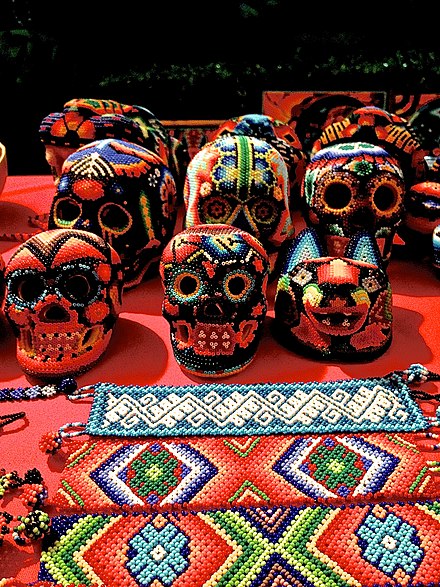Day of the Dead
Day of the Dead
Day of the Dead (Spanish: Día de Muertos) is a colorful and raucous celebration of mortality that has spread from Mexico to the United States and beyond.
Understand
.jpg/440px-Dia_de_Muertos_Tattoo_(12372459093).jpg) Day of the Dead is a peculiar Mexican institution that follows from Christian—particularly Catholic—celebrations of All Saints Day that have been held on November 1 for centuries as well as local customs that anthropomorphize Death as an angel, saint, or colorful skeleton. It is quite conceivable that some aspects of the celebration predate the introduction of Christianity into Mexico.
Day of the Dead is a peculiar Mexican institution that follows from Christian—particularly Catholic—celebrations of All Saints Day that have been held on November 1 for centuries as well as local customs that anthropomorphize Death as an angel, saint, or colorful skeleton. It is quite conceivable that some aspects of the celebration predate the introduction of Christianity into Mexico.
The Spanish name Día de Muertos is sometimes anglicized as Día de los Muertos to conform with English conventions. Confusingly, this has even been exported back to Mexico and you will sometimes see Hispanic celebrations using this variant name.
Do
.jpg/440px-Parejas_D_Muertos_(9).jpg)
 Like Christmas, Day of the Dead can be as subdued and dignified or as outlandish and chintzy as you want. Creating an altar to remember a loved one who is departed can be a powerful activity—especially if community members can leave offerings (ofrendas) as well. If you're just looking for the festivities, make sure that you try delicious sweet breads and candies known as sugar skulls. Day of the Dead is all about colorful folk art, from costumes and elaborate make-up to flower arrangements and paintings. If you're not ready to paint a mural, try making some artistic skulls (calaveras) of your own and paint your face.
Like Christmas, Day of the Dead can be as subdued and dignified or as outlandish and chintzy as you want. Creating an altar to remember a loved one who is departed can be a powerful activity—especially if community members can leave offerings (ofrendas) as well. If you're just looking for the festivities, make sure that you try delicious sweet breads and candies known as sugar skulls. Day of the Dead is all about colorful folk art, from costumes and elaborate make-up to flower arrangements and paintings. If you're not ready to paint a mural, try making some artistic skulls (calaveras) of your own and paint your face.
Destinations
The biggest celebrations will inevitably be in large Mexican cities—Mexico City, Monterrey, Puebla—but even the smallest town across the central and southern parts of the country through the Yucatán Peninsula will have altars, food vendors, music, and likely some processional. Additionally, cities in the United States with large Mexican-American populations will have celebrations.
Regions with strong indigenous cultures often express their heritage with unique tangents on the Day of the Dead theme. Be aware that Day of the Dead celebrations often start as much as a week before November 1 and end on All Souls Day, November 2.
Some of the best-known Day of the Dead celebrations include:
- Mexico City - The James Bond movie, Spectre, featured a raucously festive downtown Mexico City Day of the Dead parade, chilangos decided it looked like fun, and so it's become an annual tradition. The parade actually happens the Saturday before Day of the Dead (for 2022, the parade will be October 29).
- Mexico City - Xochimilco is a part of the city best navigated on colorful party boats called trajineras. It's also a part of the city with a rather morbid Day of the Dead tradition featuring La Llorona --- a woman mourning the loss of her children, who she drowned in the canals. Her ghost now roams the canals on Day of the Dead.
- Mixquic - The once remote village of Mixquic is now encompassed in the megalopolis of Mexico City, but it will still take a good hour and a half to get there. Mixquic is famous for its La Alumbrada celebration of Day of the Dead. All electricity is turned off in the village and the only illumination comes from seemingly millions of candles in the candlelight vigil ceremony in the local cemetery.
- Janitzio - The Patzcuaro area is rich in Purhepecha tradition, particularly in late October and early November when the town fills with visitors for the annual Day of the Dead celebrations. Purhepecha tradition holds that spirits of the dead rest in the waters of Lake Patzcuaro, and on the Night of the Dead, they float up and make their way to the top of the island to celebrate Day of the Dead with the beloved families they left behind. The spirits are guided up the hill by local fishermen waving their hooped butterfly nets.
- Aguascalientes - The city's Festival de las Calaveras runs from October 28 to November 2 and features a downtown parade along Avenida Madero.
Stay safe and respect

See also
- Halloween, a mostly American holiday which occurs the day prior
- Horror fiction, modern stories about the undead and the uncanny